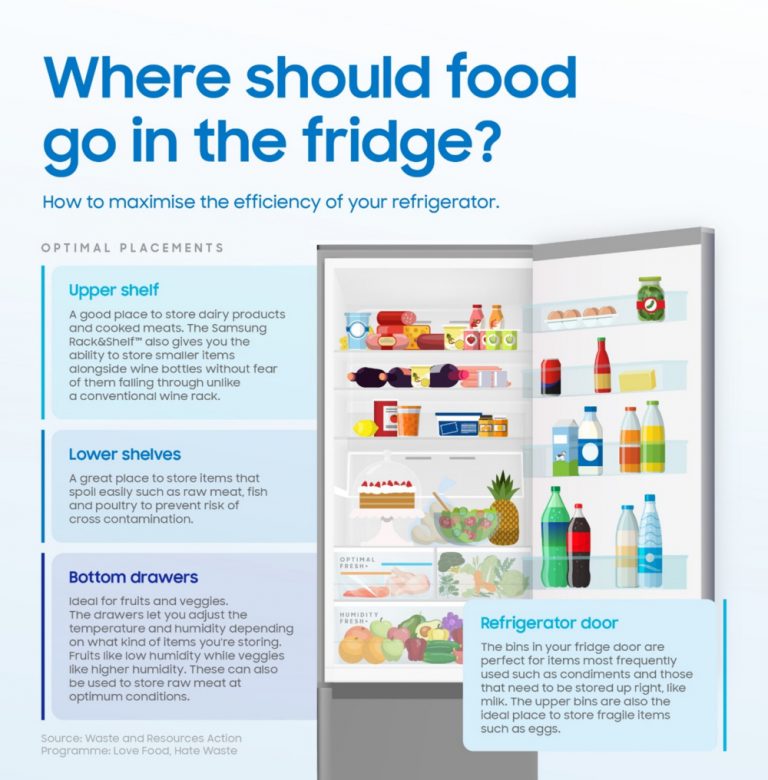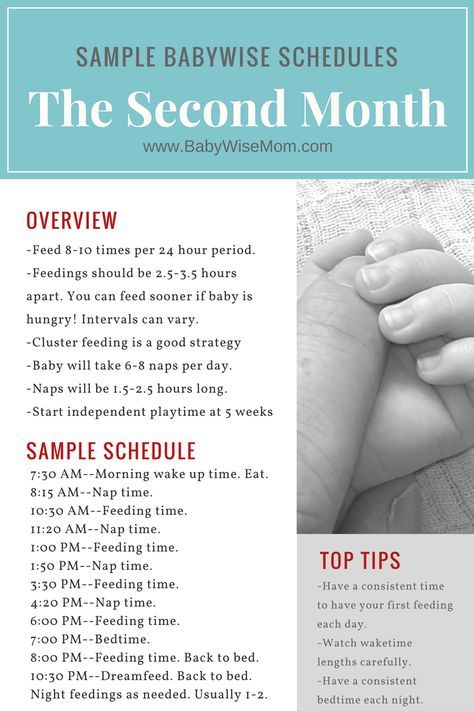Tips on spoon feeding a baby
Tips for responsive spoon feeding — Feed Eat Speak
Infant feedingWeaning
Written By Stacey Zimmels
Feed Eat Speak & allaboutbabies have teamed up to bring you our top tips for responsive spoon feeding.
We are aware that Baby-Led Weaning isn’t for every parent or every baby so here are our top tips for spoon feeding parents.
1. Follow your baby’s lead. This may sound obvious but often babies take a bit of time to get going with weaning and may not take large volumes of solids. Many parents worry about this. However, milk remains the main source of nutrition for the first year of life. It may gradually decrease your baby gets closer to one year so you have plenty of time to go at the right pace for your baby.
2. Wait for your baby to open his mouth. Just like us, babies need time to process what they are eating and the look and smell of what is being offered. This may mean they take time to consider it before opening their mouth. Make mealtimes relaxing and present the spoon slowly. Hold it close to their mouth and wait for them to open and accept it.
3. Enjoy mealtimes together. Babies (like adults) learn best when they are relaxed. They also learn from watching others. Rather than standing over your little one whilst spoon-feeding, sit down together and try to be close and at the same level as them. If you have other children try to find opportunities for family meals times. Eating alongside your baby is a great way to spark their natural curiosity about food and prepare them for self-feeding too.
4. Slow it down. Your baby is born with a natural “full switch” which will click on to avoid them over-eating, but it takes time for it to switch on. If you spoon-feed your baby quickly those opportunities to register that full feeling don’t happen. This can lead to overeating and dropping milk feeds too fast. It can also impact their ability to know when they are full as they grow up. Take it slow, allow pauses between mouthfuls and most importantly stop once you baby shows they are full (see point 5).
This can lead to overeating and dropping milk feeds too fast. It can also impact their ability to know when they are full as they grow up. Take it slow, allow pauses between mouthfuls and most importantly stop once you baby shows they are full (see point 5).
5. Move on at the right time. Your baby will become more independent as he develops. If you are spoon-feeding and find your little one reaching for the spoon take the plunge and give it to them! Yes, it might (it will) get messy but the aim with weaning is to teach your little ones to eat and form a positive relationship with food. What better way than just letting them get stuck in. It is also important to move on to more challenging chewable textures at the right time (after the first few weeks) or your little one might struggle to learn this skill. Start by offering soft sticks of finger foods and stop blending foods and offer soft foods instead (eg scrambled egg, soft pasta and sauce, meatballs and mashed potato)
6. Don’t distract them. Peppa Pig, ipads and “here comes the aeroplane” are all common methods of distraction aimed to encourage a baby to eat who isn’t showing willing. Remember, your aim is to help your baby to develop positive food habits. Mindless eating and forcing that one extra mouthful can lead to negative food associations as they grow up.
Don’t distract them. Peppa Pig, ipads and “here comes the aeroplane” are all common methods of distraction aimed to encourage a baby to eat who isn’t showing willing. Remember, your aim is to help your baby to develop positive food habits. Mindless eating and forcing that one extra mouthful can lead to negative food associations as they grow up.
weaningfeedingspoon feedingresponsive feeding
Stacey Zimmels
How to Spoon Feed Baby the Right Way!
Learn how to spoon feed baby even if you’re using baby led weaning, and how to troubleshoot baby gagging, throwing food on the floor, and more!
Affiliate links used below. See our full disclosure.
Starting solid foods is an exciting time for you and your baby! But, it’s easy to feel overwhelmed with exactly how to spoon feed your baby.
Is there a right way?
A wrong way?
Or, maybe your baby is having a hard time eating from a spoon?
As a pediatric OT, I’ll be answering all those questions so you can feel confident getting started or troubleshooting spoon feeding your baby.
When Should You Introduce Purees?
Let’s get started with the best time to start spoon feeding your baby.
In the past, it was recommended to introduce solids between 4-6 months. Some doctors would even recommend introducing thin cereals before that or adding them into the bottle.
Your parents may have fed you this way.
But, the American Academy of Pediatrics now recommends waiting until 6 months of age before introducing solids to your baby. They continue to recommend soft or pureed foods as the first introduction to solid foods in order to prevent choking.
We now know that babies’ digestion systems just aren’t mature enough to handle foods and that most don’t have the postural control for safe swallowing before 6 months.
Before 6 months, a powerful tongue thrust is also likely to be present which means your baby may inadvertently push the food back out of their mouth when you try to spoon feed them at an earlier age.
Parents often confuse this with a baby not liking the baby food, but it’s actually an involuntary action.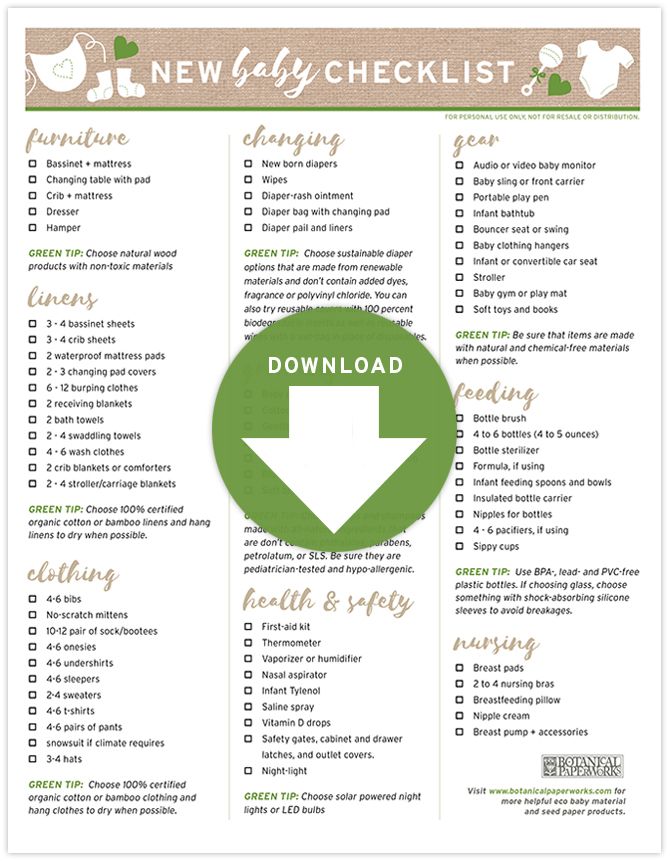
So, despite what well meaning grandparents may say, we now know waiting till 6 months is the best time frame for beginning to spoon feed your baby.
Head to our Feeding Schedule for 6-7 month olds to get an idea of how, and often when, you should be spoon feeding your baby.
What About Baby Led Weaning (BLW)?
In more recent years, there has been a huge movement towards Baby Led Weaning (BLW).
Baby led weaning is a method for introducing solid foods by allowing your baby to feed themselves rather than be spoon fed by a parent. Read about the pros and cons of Baby Led Weaning.
Baby Led Weaning gives babies the ultimate sensory experience while they eat, but it can also lead to delayed introduction of solids during your baby’s optimal window if they aren’t getting the hang of eating BLW type foods.
Some babies do really well learning to eat with BLW, and some don’t.
Whether you choose to go the BLW route or not, purees are still important to feed your baby sometimes because you’ll want them to also be able to eat foods like applesauce, yogurts, and soups.
Check out our Mega List of Table Foods for great food ideas to start with.
How to Start Spoon Feeding Baby
Step #1: Make sure that they’re 6 months old, have good head control, and can sit upright to eat and swallow.
Step #2: Get them in the right position.
The position of your baby is often overlooked. It’s easy to sit them on your lap while feeding them or feed them while they’re in the car seat. But that isn’t the safest position and can impair the development of their feeding skills.
Sitting on your lap or not in a supported seat is actually more challenging for babies. If your baby is focusing all their energy on sitting upright, they aren’t able to use their mouth as effectively.
To ensure your baby is seated properly, position them in an age appropriate booster seat or highchair with a footrest.
Ideally their hips, knees and feet should be at a 90 degree angle if possible.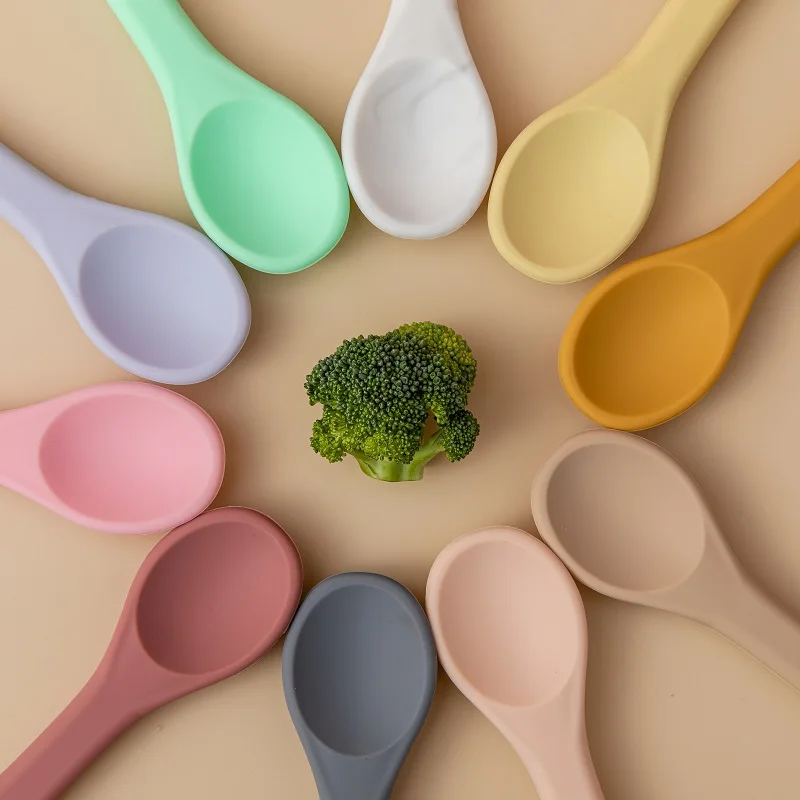
This means that when babies are first learning to eat, they should have support under their feet and they shouldn’t look slumped over. Not every highchair or booster seat does a good job keeping your little one in the right position.
My absolute favorite chair that grows with them into childhood is the Tripp Trapp, it’s an investment, but they’re so well made, they last forever.
My son is 7 and has been using it since he was 6 months old!
The Keekaroo is another option that’s a little lower in price.
Step #3: Use a spoon with a flat small bowl, it’s easier for your baby to remove the food.
The bowl of the spoon is so important. You want it to be mostly flat or to have a shallow bowl. That means it can’t hold too much of the puree on it.
The spoon should also have a narrow bowl. If your baby is right around 6 months old, their mouth isn’t big. The narrow bowl fits in their mouth much better than a big wide spoon.
See a list of our favorite spoons at the end.
Step #4: Choose a totally smooth thinner baby food.
If you’re using store bought baby food use stage 1 for the first feedings. If you’re making homemade baby food, you don’t want the food to be too thick. Think about making it thick enough for baby to swallow, but not so thin it’s like liquid.
Homemade baby food at this stage should spill off the spoon easily, but still have some stuck to the spoon when you turn it upside down.
Step #5: Place the right amount of puree on the spoon.
You’ll want to avoid overfilling or under-filling the spoon. You should have some puree on it, ideally near the front of the spoon.
Avoid scooping and loading up the spoon with as much puree as possible. This can be really overwhelming to your baby, especially if they’re just learning to eat purees.
Too much food in their mouth can also trigger their gag reflex.
If your baby does gag, don’t panic, it’s normal.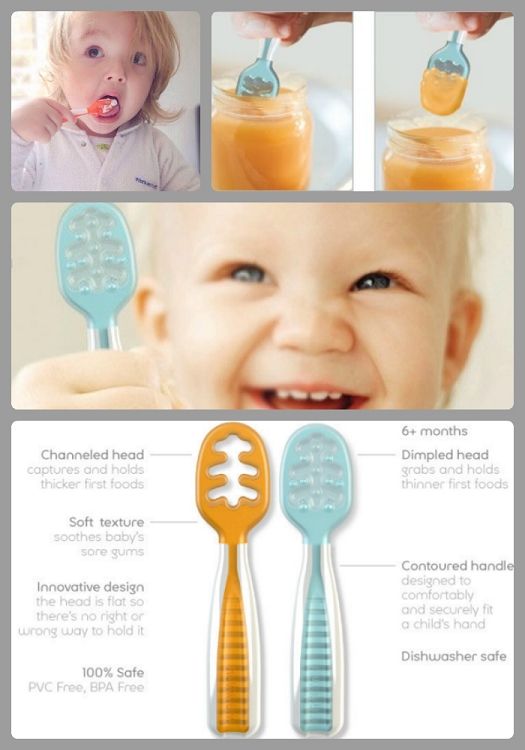 Gagging and choking are two different things. Read more about what to do when babies gag eating.
Gagging and choking are two different things. Read more about what to do when babies gag eating.
Step #6: Let your baby decide when to take a bite.
Place the spoon right in front of your baby and wait until they open their mouth. This puts them in charge of their responsibility right from the start, they are the ones that decide to eat.
You want to avoid opening their mouth for them or trying to sneak a bite in their mouth when they look away.
Helping your baby learn that they get to decide when to take a bite can reduce feeding battles and picky eating in the years to come.
Step #7: Place the spoon in the center of their mouth.
The spoon should go in the center of their mouth, above their tongue. You may gently use the back of the spoon to add a small bit of pressure to the middle belly of the tongue.
This is helpful if their tongue seems to be moving quite a bit.
Step 8: Wait for them to close their mouth.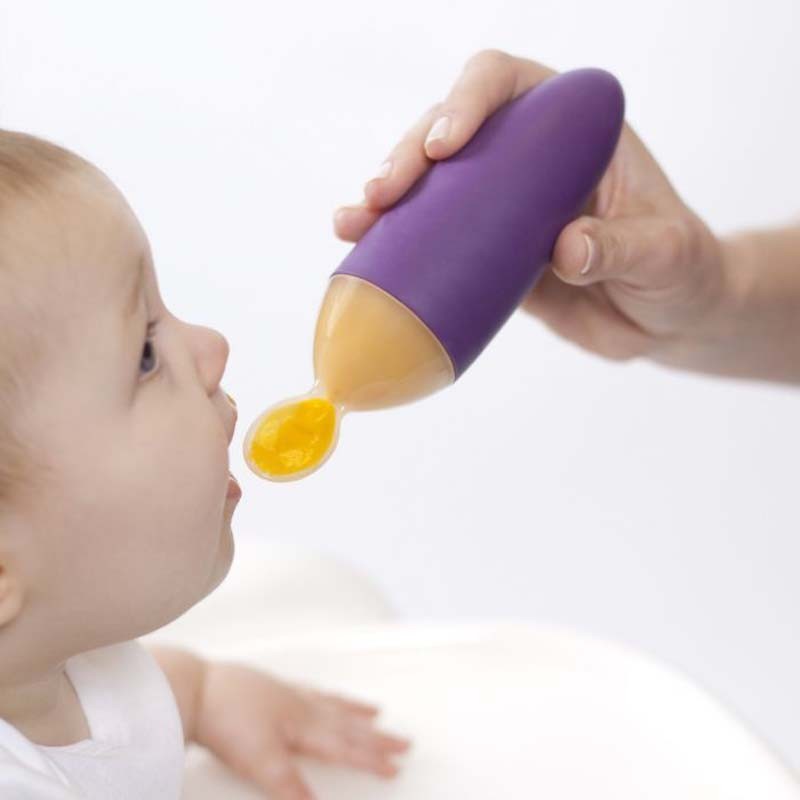
When you’re excited and you really want them to take a bite, it can be hard to wait! But be sure to wait until they close their mouth on the spoon.
This lets them know what their job is, and helps lay the foundation for them to be able to feed themselves.
What to Avoid When Spoon Feeding Baby…
You have 8 simple steps to follow! But, there are a few things you’ll want to avoid. You’ll likely see others doing these things while feeding their babies, because they’re all very common.
However, each of them can cause difficulties with eating and swallowing either in the moment you’re feeding your baby or in the future. Here’s what to avoid…
- Avoid scraping food on the roof of your baby’s mouth. You want to wait until your little one closes their mouth on the spoon.
- Don’t feed them in a reclined position. Car seats, strollers, and infant positioners all should be avoided. An upright high chair or booster seat is ideal to make sure your baby doesn’t gag, choke, or aspirate.

- Avoid distractions like the TV, phone, or toys. If they’re distracted while eating, they aren’t fully experiencing all the different flavors and textures.
- No force feeding. Let your little one decide when to take a bite. This reduces the chance of picky eating later on and sets them up for positive mealtimes in the future.
In these early days, some babies need a lot of time to get used to purees. However, if your baby is reaching the 8-9 month mark and still struggling, there could be some underlying difficulties that need addressed.
See our free workshop to learn more and contact your child’s doctor.
- Don’t overfill the spoon. You want a medium amount of puree on the spoon, near the front of the bowl.
Troubleshooting Spoon Feeding Challenges
It’s very normal for babies to need some help getting the hang of eating purees. They’re learning and may need a little more time. Here’s some common challenges you might be faced with and what you can do…
They’re learning and may need a little more time. Here’s some common challenges you might be faced with and what you can do…
Challenge #1: Your baby won’t open their mouth
When your baby won’t open their mouth for the spoon, this can be really discouraging as a parent of a new eater!
Modeling is especially helpful in these cases. Take your own spoon and a little bite of the puree. Open your mouth wide and really over exaggerate what you’re doing.
Show your baby how to do it.
You can also try placing a mirror in front of your baby while they eat or give them their own spoon that is pre-dipped with puree to try out.
Challenge #2: Your baby won’t close their mouth on the spoon
If your baby won’t close their mouth on the spoon, scraping the puree into their mouth is tempting. You want to avoid this!
It doesn’t teach them how to use their muscles to eat. It also teaches them that they have to eat a particular food, which can encourage pickiness later on.
Frequently, if they don’t close their mouth on the spoon, it’s because they don’t know they’re supposed to.
You can encourage this by very gently rolling your finger above their upper lip in a downward motion towards their mouth. Showing them how to take a bite with an exaggerated close is also helpful.
Keep practicing for up to 8 months of age before seeking more help from the doctor or a feeding therapist.
Challenge #3: Your baby gags with purees
Gagging can get a bad wrap. Gagging happens first as a protective mechanism to prevent your baby from choking. But it can also turn into a problem if it starts to happen often. Or, before food even hits their mouth.
Sometimes excessive gagging happens because your baby’s mouth is sensitive to sensory input, or the textures of food.
It can be helpful to desensitize their mouth with teethers or toothbrushing. You can brush their gums even if they don’t have teeth yet!
Challenge #4: Your baby throws their bowl or spoon
We hear parents tell us that their baby is throwing their food, plate, or utensils all the time. If your baby is doing this, you’re not alone at all!
If your baby is doing this, you’re not alone at all!
Usually this happens just because they’re testing things out at first. It makes a fun noise or you make a funny face whenever they do it.
It can be tempting to react negatively whenever food is thrown. Try to resist the urge and stay as neutral as possible. A negative reaction is still a reaction and can sometimes encourage them to do it more.
Try using a simple phrase like, “our food stays on the tray” and move on. It can also be helpful to use plates and bowls that suction well to their highchair to buy you a bit more time before the food flies.
Learn more in how to help babies and toddlers stop throwing food.
Challenge #5: Your baby always wants to hold the spoon
This is actually such a good thing, even though it can feel frustrating when you’re just introducing purees. They’re motivated to feed themselves!
Give them a spoon of their own that has been dipped in a little bit of puree while also having your own spoon. You can take turns doing the feeding.
You can take turns doing the feeding.
It might be frustrating because they will make a big mess at first and likely will get just a little bit of puree in their mouth. This is a great step towards their independence!
While 6 months is the perfect time to start spoon feeding your baby, and you should give your baby plenty of time to get the hang of it, your baby should be eating purees regularly by 8 months of age, even if it’s a small amount.
If you’ve tried all the tips and tricks we’ve suggested and they still aren’t eating solids by 9 months, it’s time to get some more help!
Our free Table Foods Workshop is the perfect place to start. It’s full of suggestions that you can start using immediately. Save your seat HERE.
Our Favorite Baby Feeding Spoons
- Take and toss spoons
- These are great spoons. They have a narrow and flatter bowl. They’re also super affordable. You certainly can take and toss them, as they suggest.
 But, they can also be quickly hand washed and reused. The spoons are a bit softer and more flexible. They’re great spoons to start with!
But, they can also be quickly hand washed and reused. The spoons are a bit softer and more flexible. They’re great spoons to start with!
- These are great spoons. They have a narrow and flatter bowl. They’re also super affordable. You certainly can take and toss them, as they suggest.
- Maroon spoon
- Maroon spoons are spoons you commonly see therapists use. They’re a bit pricier though. The bowl is relatively narrow and flat, which is perfect for babies to pull puree off of more easily. These spoons are made from harder plastic.
- Flat Spoon Dippers
- These spoons were intended for babies to feed themselves. The bowl is narrow, textured, and completely flat. There is also a guard to prevent your baby from pushing the spoon too far down. Great for reducing gagging.
- EZ PEZE bowl
- While this isn’t a spoon, it’s a great tool to have on hand when you’re feeding your baby purees. It suctions to the tray and doesn’t slip very easily. It can be really helpful, especially if your baby loves to throw their bowl.

- While this isn’t a spoon, it’s a great tool to have on hand when you’re feeding your baby purees. It suctions to the tray and doesn’t slip very easily. It can be really helpful, especially if your baby loves to throw their bowl.
You’re all set! It’s time to feed that sweet little baby. Try to have fun. Let your baby play, experiment, and laugh while eating.
Let them get messy! (See why here)
Got any questions? Leave them in the comments below, we respond to every single one.
And, if you want to get ready for the next steps of feeding, table foods, grab our guide for teaching your baby how to learn to chew and eat them here!
More on Feeding Babies
5 Things Parents With They’d Known Sooner About Feeding Their Baby or Toddler
Why Your Baby Should Be Putting Toys in Their Mouth
Feeding Schedule for 8, 9 and 10 Month Olds
Must-Know Pros and Cons of Using Baby Food Pouches
Andrea Timler is a licensed occupational therapist and part of the Your Kid’s Table Team. She has over 7 years experience with expertise in development and feeding in babies, toddlers, and children. Andrea also has 4 kiddos of her own at home.
Right and wrong ways of spoon feeding
Right and wrong ways of spoon feeding
Translator: Marina Lelyukhina
Editor: Marina Lelyukhina ark0://com/blog:therapeutic90://com/blog:therapeutic the-right-and-wrong-way-to-spoon-feed/
Our Facebook group: https://www.facebook.com/specialtranslations
Our VKontakte public: https://vk.com /public57544087
If you liked the material - help those who need help: http://specialtranslations.ru/need-help/
Copying the full text for distribution in social networks and forums is possible only by quoting publications from the official pages of Special Translations or through link to the site. When quoting text on other sites, put the full translation heading at the beginning of the text
Did you know that spoon-feeding can be wrong? The wrong way is to raise your hand up as if you want to remove the spoon from the child's mouth. Thus, before the food is in his mouth, the spoon will scratch his teeth, tongue and upper lip.
Thus, before the food is in his mouth, the spoon will scratch his teeth, tongue and upper lip.
Scraping food off a spoon while eating is not correct. This method is especially unsuitable for children with a delay in oral-motor development. This makes it impossible for the lips to do their job of closing around the spoon. It also causes the baby to reach for the spoon, as can be seen in the picture above or below at the start of the video.
The correct way to spoon feed: place the spoon on the top of the tongue and hold until the baby closes its lips. Then take the spoon straight out of your mouth (don't hold it at an angle). The child should sit straight, not lift his head. As the girl's mother rightly noted in the video, thanks to this position she eats, not you feed her. On the last spoon in the video, you can see how her lips work.
Children should instinctively close their lips, but if they fail, there are several ways to help build oral motor skills:
- Give it time - you can hold the spoon until the child closes their lips.

- You can also gently press the spoon on your tongue to stimulate your lips.
- For children with strong oral sensory defenses, a vibrating spoon can help wake up the mouth and reduce sensitivity. Tongue massage before meals (and throughout the day) can also help
- You can stretch your lips slightly beforehand to help them grasp the spoon.
There are several techniques to stretch the lips:
- Gently pull the upper lip down with the tip of your finger (or your whole finger). Repeat the same on the lower lip - gently pull it up. The same can be done with the Y-Chew probe
- Gently grab a piece of skin between the nose and upper lip and pull it down. Repeat with the area of skin just under the lower lip - pull it up.
- Bring your thumb and forefinger together and place them between your nose and upper lip, fingers apart, pressing them against your lip. Repeat with lower lip
- Stand behind the child and place the index finger on the upper lip and the thumb under the lower lip, close the fingers like scissors to help the child close the lips
Your therapist will help you learn how to put these techniques into practice.![]() Remember that stretching your lips before meals may not be enough. Watch how the child eats and if he stops working with his lips, then repeat the exercises again.
Remember that stretching your lips before meals may not be enough. Watch how the child eats and if he stops working with his lips, then repeat the exercises again.
Also, try not to put too much food on the spoon. No "with a slide." The best are small pieces that are easy to handle. A large amount of food in one sitting is not easy to collect.
Usually when I come across parents who are not feeding their baby properly, it's because they just don't know how, or they're in too much of a hurry. So now that you know exactly what to do and how to do it, give yourself enough time to practice. This will take time, but in the future, less food will fall out of the mouth, the child will play less and will get a lot of benefit from the ability to work well with lips.
Categories: occupational therapy, feeding.
Baby's first spoon | How to teach a child to eat with a spoon by himself
A spoon is an excellent exercise machine for developing fine motor skills. It's hard to eat with a spoon. You need to be able to hit the right end of the spoon first into the plate, then into the mouth, and even not drop the food. Most babies easily cope with this difficult task after a year. That is why in many books the chapter on introducing the spoon begins with the phrase: "Your child is already a year old, it's time to teach him to eat on his own." Indeed, in a year a child will learn to use a spoon faster, but an earlier acquaintance with it will improve the coordination of the baby's hands. So why waste time?
It's hard to eat with a spoon. You need to be able to hit the right end of the spoon first into the plate, then into the mouth, and even not drop the food. Most babies easily cope with this difficult task after a year. That is why in many books the chapter on introducing the spoon begins with the phrase: "Your child is already a year old, it's time to teach him to eat on his own." Indeed, in a year a child will learn to use a spoon faster, but an earlier acquaintance with it will improve the coordination of the baby's hands. So why waste time?
Your baby will not be able to use a spoon before 7-8 months. First, the baby must learn to sit confidently so as not to stagger (do not swing, do not fall) from each wave of the hand. Secondly, it is more convenient to eat from a full plate, that is, a portion of complementary foods should be large enough.
The most convenient product for learning is a thick viscous porridge. Such porridge can be brought to the mouth even with an inverted spoon.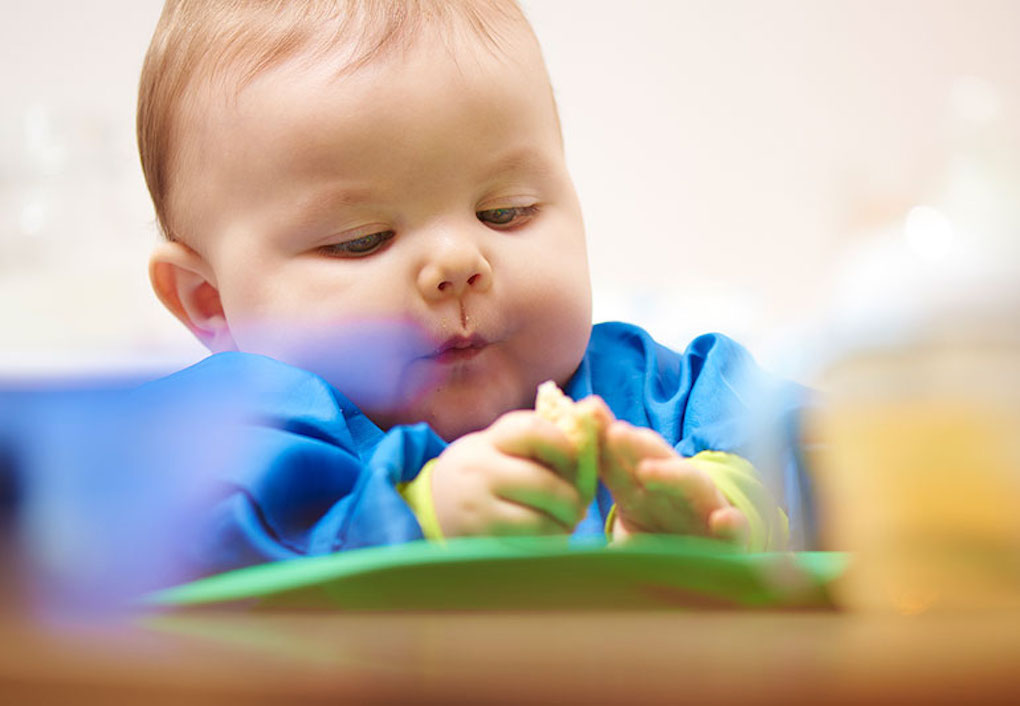 So, as soon as the baby gets used to eating 50-80 grams of porridge, give him a spoon in his hands.
So, as soon as the baby gets used to eating 50-80 grams of porridge, give him a spoon in his hands.
The correct first spoon should be light, made of silicone or food-grade plastic, with a comfortable long handle. You can also use an ordinary tea spoon or a silver spoon donated "for the first tooth", but always with a rounded handle, without sharp corners. A silver spoon must be made of table silver and have an appropriate quality certificate. Keep in mind that some babies don't like the feel of cold metal in their mouths, so it's best to opt for a special baby spoon.
For the first attempts, it is better to choose a small narrow spoon, it fits well in a small mouth. Such a spoon can be bought at any children's store, but the product must be certified. At the same time, in the economic department, get a large piece of oilcloth.
So, put a plate of porridge and give the baby a spoon. It’s good if the baby has managed to get a little hungry by this moment. First, help your child develop the skill correctly. Grab your baby's hand with your hand and together bring the spoon to your mouth. Part of the porridge will definitely end up on the floor, mother and walls. This is fine. The child can get into the plate with both hands and lick the porridge from his hands, lean towards the plate and eat directly from it. Smart children fill the spoon with their free hand. Allow your child these experiments, in no case scold for carelessness! Now the baby is studying, do not interfere with him. After about five minutes, take the second spoon and feed your baby slowly. Each time, give the crumbs more and more time for independent food, so that in a few months he can eat a significant part of the portion himself.
Grab your baby's hand with your hand and together bring the spoon to your mouth. Part of the porridge will definitely end up on the floor, mother and walls. This is fine. The child can get into the plate with both hands and lick the porridge from his hands, lean towards the plate and eat directly from it. Smart children fill the spoon with their free hand. Allow your child these experiments, in no case scold for carelessness! Now the baby is studying, do not interfere with him. After about five minutes, take the second spoon and feed your baby slowly. Each time, give the crumbs more and more time for independent food, so that in a few months he can eat a significant part of the portion himself.
When the child is used to using a spoon, seat him or her at a common table. Toddlers copy the movements of adults, their behavior at the table. So, on the example of the elders, the child will learn accuracy. At about two years old, a child will be able to eat his soup without spilling a drop.

